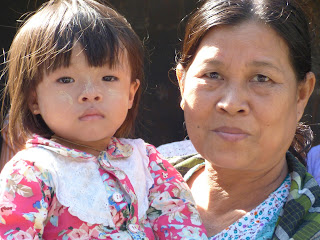il 31 ottobre - il 16 novembre
Myanmar
I have given a lot of thought to how/what I will write about my time in Myanmar. It was an extraordinary experience to be in a country whose military government had kept it more or less in isolation for many years. Although foreigners did enter the country prior to 2010, it was only then that the National League for Democracy Party actually ended its boycott of international visitors, having felt that tourism would only legitimize and generate income for the repressive and corrupt regime in power. Even now, there are guidelines as to where to go, what to see, what to say, and how to best support the people.
There is a magic to Myanmar, but, I fear, this is to a large extent, for the tourist; the beauty of the countryside, the splendor of the pagodas, the awe-inspiring statues of the Buddha, the warm welcomes from so many, I will write much about the delight and the joy that I felt in this country, but I would be remiss if this is the only message I leave you with. It is the people I met while on this journey and all of the others who have known the fear and oppression of a military dictatorship to whom I dedicate my stories with the anticipation that the current election will truly be the beginning of freedom for all of you.
The second largest country in Southeast Asia, the Republic of the Union of Myanmar was for many years known as Burma, the name given to it by the British and referring to the country’s largest ethnic group. With a total of 135 ethnic groups who have not always lived harmoniously, 15 provinces, 7 states, and 8 regions, its long history was one of powerful, revered, but often self-serving and ineffectual royalty who, as part of their legacy, were responsible for the building of magnificent palaces and mystical stupas. Britain, over time and primarily in the 19th century, began colonizing small chunks of territory in Lower Burma and in 1885, it effectively took over Upper Burma, exiling King Thibaw to India.
Myanmar’s modern history, after independence in 1948, has been one of persistent human rights violations, ethnic strife, government cronyism, and a failed economic policy that resulted in widespread poverty. International sanctions were eased a number of years ago and, from what I saw in towns and villages that I visited, there is a real hope for improvement in the country and, based on the November election, an active participation in the democratic process, something that was unheard of not that many years ago.
Most of my stories will share the foreignness, the mystery, the cultural and religious discoveries that I had while on this adventure. Myanmar is so many things…small towns and villages, rice fields and tea shops, bicycles and cycles, and the largest number of Buddhist pagodas anywhere in the world…a place of reverence, serenity, and meditation…but it is also busy cities and clogged streets, universities and challenging intellect, economic growth and development...a simmering cauldron with an unknown future.
And so I begin...with faces...
Burmese women have, since ancient days, protected their skin with a natural "cosmetic, sunscreen, anti-aging and insect repellent." They make a yellow-white paste from the bark of the thanaka tree and spread it on their faces, creating all sorts of delightful and arresting patterns that are quite lovely and only enhance their natural beauty. The cream keeps the skin smooth, healthy, and moist and is also used on children as the sun is hot and its rays are damaging and unforgiving.














No comments:
Post a Comment